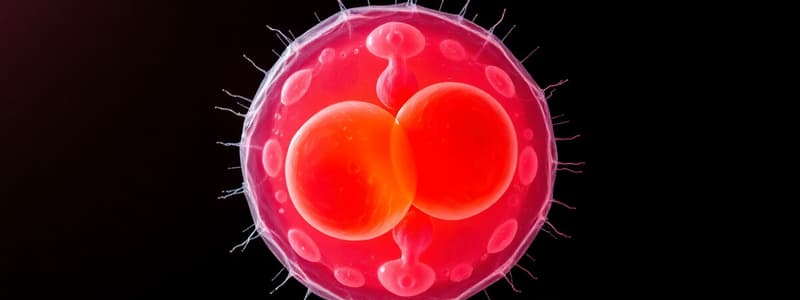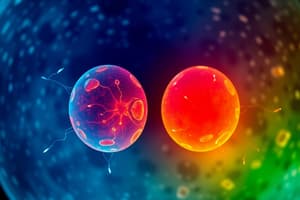Podcast
Questions and Answers
Which of the following is a key difference between mitosis and meiosis?
Which of the following is a key difference between mitosis and meiosis?
- Mitosis involves spindle formation, while meiosis does not.
- Mitosis involves chromosome condensation, while meiosis does not.
- Mitosis produces diploid cells for tissue repair, while meiosis produces haploid gametes for sexual reproduction. (correct)
- Mitosis occurs only in somatic cells, while meiosis occurs only in gametes.
The purpose of mitosis is to enhance genetic variation through sexual reproduction.
The purpose of mitosis is to enhance genetic variation through sexual reproduction.
False (B)
How many pairs of autosomes do humans possess?
How many pairs of autosomes do humans possess?
22
______ are diploid body cells, such as skin cells.
______ are diploid body cells, such as skin cells.
Match the following terms with their descriptions:
Match the following terms with their descriptions:
During which phase of the cell cycle is DNA in the form of chromatin?
During which phase of the cell cycle is DNA in the form of chromatin?
Cytokinesis in mitosis results in two genetically different daughter cells.
Cytokinesis in mitosis results in two genetically different daughter cells.
What event occurs during prophase 1 of meiosis that increases genetic variation?
What event occurs during prophase 1 of meiosis that increases genetic variation?
During the S phase of the cell cycle, 46 chromosomes replicate to form ______ chromatids.
During the S phase of the cell cycle, 46 chromosomes replicate to form ______ chromatids.
What is the end result of meiosis II?
What is the end result of meiosis II?
Random fertilization is a mechanism that contributes to genetic variation.
Random fertilization is a mechanism that contributes to genetic variation.
How much DNA is shared between siblings, on average?
How much DNA is shared between siblings, on average?
Mendel's observation of a 3:1 ratio in the F2 generation of a monohybrid cross indicated the principle of ______ and recessiveness.
Mendel's observation of a 3:1 ratio in the F2 generation of a monohybrid cross indicated the principle of ______ and recessiveness.
What is Mendel's law of segregation?
What is Mendel's law of segregation?
A genotype refers to the physical trait expressed by an organism.
A genotype refers to the physical trait expressed by an organism.
Define the term 'allele'.
Define the term 'allele'.
An allele that masks the expression of another allele is referred to as ______.
An allele that masks the expression of another allele is referred to as ______.
In a testcross, an unknown genotype is crossed with which of the following?
In a testcross, an unknown genotype is crossed with which of the following?
Linked genes assort independently during meiosis.
Linked genes assort independently during meiosis.
State Mendel's law of independent assortment.
State Mendel's law of independent assortment.
The probability of two independent events occurring together is the ______ of their individual probabilities.
The probability of two independent events occurring together is the ______ of their individual probabilities.
Which inheritance pattern requires two copies of the affected allele to be expressed?
Which inheritance pattern requires two copies of the affected allele to be expressed?
In autosomal dominant inheritance, carriers exist for the affected allele.
In autosomal dominant inheritance, carriers exist for the affected allele.
What does a chi-square analysis determine?
What does a chi-square analysis determine?
A p-value less than 0.05 in a chi-square analysis indicates that the null hypothesis is ______.
A p-value less than 0.05 in a chi-square analysis indicates that the null hypothesis is ______.
What is typically used to notate a wild-type allele?
What is typically used to notate a wild-type allele?
Mutation is the primary source of new alleles.
Mutation is the primary source of new alleles.
Define 'loss-of-function' mutation.
Define 'loss-of-function' mutation.
In incomplete dominance, when a red flower is crossed with a white flower, the resulting flowers are ______.
In incomplete dominance, when a red flower is crossed with a white flower, the resulting flowers are ______.
Which blood type system is an example of codominance?
Which blood type system is an example of codominance?
A lethal allele always causes death in the heterozygous condition.
A lethal allele always causes death in the heterozygous condition.
Define epistasis.
Define epistasis.
A dihybrid cross with dominant epistasis typically yields a phenotypic ratio of ______.
A dihybrid cross with dominant epistasis typically yields a phenotypic ratio of ______.
What does complementation analysis determine?
What does complementation analysis determine?
Pleiotropy refers to a single gene having only one phenotypic effect.
Pleiotropy refers to a single gene having only one phenotypic effect.
Why are X-linked recessive disorders more likely to affect males than females?
Why are X-linked recessive disorders more likely to affect males than females?
Milk production is an example of a ______ trait, which is limited to one sex.
Milk production is an example of a ______ trait, which is limited to one sex.
What does penetrance measure?
What does penetrance measure?
Expressivity refers to the percentage of individuals showing a particular phenotype, whereas penetrance is the range/degree/severity of expression.
Expressivity refers to the percentage of individuals showing a particular phenotype, whereas penetrance is the range/degree/severity of expression.
Give an example of how the environment can influence gene expression.
Give an example of how the environment can influence gene expression.
The severity of a genetic disorder increasing over generations is due to ______ repeat expansions.
The severity of a genetic disorder increasing over generations is due to ______ repeat expansions.
What is imprinting?
What is imprinting?
Epigenetics involves alterations to the DNA sequence itself.
Epigenetics involves alterations to the DNA sequence itself.
What is the maternal effect?
What is the maternal effect?
The presence of both mutant and normal organelle DNA in the same cell is known as ______.
The presence of both mutant and normal organelle DNA in the same cell is known as ______.
Flashcards
Mitosis vs. Meiosis Differences
Mitosis vs. Meiosis Differences
Mitosis results in diploid cells (2n=46) for tissue repair. Meiosis produces haploid gametes (n=23) via two divisions and crossing-over.
Purpose of Mitosis vs. Meiosis
Purpose of Mitosis vs. Meiosis
Mitosis is for growth, tissue repair, and asexual reproduction. Meiosis is for sexual reproduction and genetic variation.
Human Chromosome Count
Human Chromosome Count
Humans have 46 total, arranged in 23 pairs (22 autosomes, 1 sex chromosome pair).
Autosomes, Somatic Cells, Gametes
Autosomes, Somatic Cells, Gametes
Signup and view all the flashcards
Diploid vs. Haploid Cells
Diploid vs. Haploid Cells
Signup and view all the flashcards
Homologous Chromosomes vs Sister Chromatids
Homologous Chromosomes vs Sister Chromatids
Signup and view all the flashcards
What is Chromatin?
What is Chromatin?
Signup and view all the flashcards
Cell Cycle Phases
Cell Cycle Phases
Signup and view all the flashcards
Chromosomes vs. Chromatin
Chromosomes vs. Chromatin
Signup and view all the flashcards
Mitosis Phases
Mitosis Phases
Signup and view all the flashcards
Meiosis Stages
Meiosis Stages
Signup and view all the flashcards
Crossing Over Timing
Crossing Over Timing
Signup and view all the flashcards
Meiosis and Genetic Variation
Meiosis and Genetic Variation
Signup and view all the flashcards
Mendel's Law of Segregation
Mendel's Law of Segregation
Signup and view all the flashcards
Genes, Alleles, Genotype, Phenotype
Genes, Alleles, Genotype, Phenotype
Signup and view all the flashcards
What is a Testcross?
What is a Testcross?
Signup and view all the flashcards
Autosomal Recessive Inheritance
Autosomal Recessive Inheritance
Signup and view all the flashcards
Autosomal Dominant Inheritance
Autosomal Dominant Inheritance
Signup and view all the flashcards
Chi-Square Analysis
Chi-Square Analysis
Signup and view all the flashcards
Source of New Alleles
Source of New Alleles
Signup and view all the flashcards
Types of Mutations
Types of Mutations
Signup and view all the flashcards
Incomplete Dominance
Incomplete Dominance
Signup and view all the flashcards
Codominance
Codominance
Signup and view all the flashcards
Lethal Allele
Lethal Allele
Signup and view all the flashcards
Epistasis
Epistasis
Signup and view all the flashcards
Pleiotropy
Pleiotropy
Signup and view all the flashcards
X-linked Recessive Disorders
X-linked Recessive Disorders
Signup and view all the flashcards
Sex-limited Inheritance
Sex-limited Inheritance
Signup and view all the flashcards
Sex-influenced Inheritance
Sex-influenced Inheritance
Signup and view all the flashcards
Penetrance vs. Expressivity
Penetrance vs. Expressivity
Signup and view all the flashcards
Imprinting
Imprinting
Signup and view all the flashcards
Epigenetics
Epigenetics
Signup and view all the flashcards
Organelle Heredity
Organelle Heredity
Signup and view all the flashcards
Maternal Effect
Maternal Effect
Signup and view all the flashcards
Study Notes
Mitosis vs. Meiosis
- Mitosis produces diploid cells (2n=46) for tissue repair
- Meiosis produces haploid gametes (n=23) for sexual reproduction
- Meiosis involves two cell divisions and crossing-over
- Mitosis and meiosis are both preceded by interphase
- Mitosis and meiosis both include chromosome condensation, spindle formation, and cytokinesis
Purposes of Mitosis vs. Meiosis
- Mitosis functions in growth, tissue repair, and asexual reproduction
- Meiosis enhances genetic variation in sexual reproduction
Human Chromosomes
- Humans have 46 total chromosomes, or 23 pairs
- 22 pairs are autosomes
- 1 pair is sex chromosomes
Autosomes, Somatic Cells, and Gametes
- Autosomes: 22 pairs of non-sex chromosomes
- Somatic cells: diploid body cells (e.g., skin cells)
- Gametes: 1 pair of reproductive cells (eggs and sperm)
Diploid vs. Haploid Cells
- Somatic cells (diploid 2n) contain two sets of chromosomes
- Gametes (haploid n) contain one set of chromosomes
Homologous Chromosomes vs. Sister Chromatids
- Homologous chromosomes are chromosome pairs (one from each parent) with the same genes in the same order but different alleles
- Sister chromatids are genetically identical copies of a single chromosome, connected at the centromere
Chromatin
- Chromatin is an uncondensed DNA-protein complex during interphase
Cell Cycle Phases
- Interphase (90% of cycle)
- G1: major growth state
S Phase
- DNA replication occurs (46 chromosomes -> 92 chromatids)
- Centrosomes replicate
G2 Phase
- Preparation for cell division
- Centrosomes move to opposite poles
M Phase
- Mitosis (cell division)
- Cytokinesis
DNA Condensation
- DNA is condensed into chromosomes during cell division (meiosis and mitosis)-prophase
- DNA is in the form of chromatin during interphase (G1, S, G2) for transcription and replication
Mitosis Phases
- Prophase: chromosomes condense, nuclear envelope breaks down, spindle fibers form
- Metaphase: chromosomes align at the metaphase plate
- Anaphase: sister chromatids separate and move to opposite poles
- Telophase: chromosomes de-condense, nuclear envelopes reform
- Cytokinesis: cytoplasm divides, forming two genetically identical 2n daughter cells
Meiosis I
- P: homologous chromosomes pair up, crossing over happens
- M: homologous pairs align at the metaphase plate
- A: homologous chromosomes separate
- T: two haploid cells form, each with duplicated chromosomes
Meiosis II
- P: chromosomes condense
- M: chromosomes align at the metaphase plate (random order)
- A: sister chromatids separate
- T: four haploid 1n daughter cells (gametes) form
Crossing Over
- Crossing over (recombination) occurs during prophase 1 of meiosis
- Homologous chromosomes pair up and exchange genetic material
Genetic Variation in Meiosis
- Meiosis contributes to genetic variation through crossing over
- Meiosis contributes to genetic variation through independent assortment
- Meiosis contributes to genetic variation through random fertilization (different egg and sperm fertilize)
DNA Sharing Among Relatives
- Parent: 50%
- Siblings: 50% (may vary due to recombination)
- Grandparents: 25%
Gregor Mendel's Pea Plants
- Easy to grow
- Distinct traits
- Controlled mating
Mendel's Monohybrid Crosses
- F2 Ratio: 3:1 (3 tall; 1 short), indicating dominance and recessiveness
Mendel's Law of Segregation
- Alleles segregate during gamete formation
- Each gamete carries only one allele for each gene
Genetic Terms
- Gene: DNA segment for a trait
- Allele: gene variant (T/t)
- Genotype: genetic makeup (TT/tt)
- Phenotype: physical trait (tall/short)
- Dominant: allele that masks the recessive allele
- Recessive: allele that is masked by the dominant allele
- Homozygous: two identical alleles for a gene
- Heterozygous: two different alleles for a gene
Testcross
- Cross unknown (T?) with homozygous recessive (tt)
- If offspring show recessive trait, the parent was Tt (heterozygous)
Mendel's Dihybrid Crosses
- F2 ratio: 9:3:3:1
Mendel's Law of Independent Assortment
- Alleles for different genes separate independently
Linked Genes
- Genes located close together on the same chromosome
- They do not assort independently and are inherited together
Product Law of Probabilities
- The probability of two independent events occurring together is the product of their individual probabilities
- P(A and B)= P(A)*P(B)
Autosomal Recessive Inheritance
- Requires two copies (aa) to be affected
- Carrier: Aa
Autosomal Dominant Inheritance
- Only one copy (Aa/AA) needed to be considered affected
- There is no carrier
Chi-Square Analysis
- Tests if observed data matches expected ratios
Chi-Square Analysis Formula
- x2 = Σ(Οί – Εί)2/Ei
P-Value
- P<0.05: significant deviation/difference (null hypothesis rejected)
Wild-Type Allele
- The most common allele (+) subscript
Source of New Alleles
- Mutation is the source
Loss-of-Function Mutation
- Reduced/no protein
Gain-of-Function Mutation
- Enhanced/new function
Silent Mutation
- No effect
Incomplete Dominance
- Either allele is completely dominant or recessive (blended genotype: red+white flowers=pink)
Codominance
- Both alleles are fully expressed (AB blood type)
Blood Groups
- MN: codominant
- ABO: A/B codominant, O recessive
- Rh: Rh+ dominant, Rh- recessive
Lethal Allele
- Causes death during the embryonic period if homozygous (TT=lethal)
Epistasis
- When one gene influences (affects or masks) the expression of another
- Dominant epistasis (12:3:1 ratio)
Recessive epistasis
- Recessive epistasis (9:4:3 ratio)
Complementation Analysis
- If two mutants crossed -> wild type -> mutations in different genes
- If two mutants crossed -> mutant -> mutations happen in the same gene
Pleiotropy
- When a single gene has multiple phenotypic effects
- Example: Marfan syndrome affects connective tissues in many body parts
X-Linked Recessive Disorders
- Males are more affected (XY only one X chromosome -> no “backup” X)
Sex-Limited Inheritance
- A certain phenotype limited to only one sex (e.g., milk production)
Sex-Influenced Inheritance
- More expressed in one sex (e.g., baldness)
Penetrance
- % showing that phenotype
Expressivity
- Range/degree/severity of expression of that phenotype
Environmental Influence
- Temperature-sensitive gene affecting fur color in Siamese cats (more black pigments in winter)
Genetic Anticipation
- The severity of a genetic disorder increases over generations due to trinucleotide repeat expansions
Imprinting
- Gene expression depends on which parent it was inherited from
- Example: PWS-paternal inherited gene, AS-maternal inherited gene
Epigenetics and DNA Methylation
- Heritable changes in gene expression without altering DNA sequences
- DNA methylation influences gene activity and silences genes
Organelle Heredity
- Traits inherited through organelles (mitochondria/chloroplasts)
Maternal Effect
- Phenotype determined/affected by the mother's genotype (gene products presented in the egg)
Heteroplasmy
- Mixed organelle DNA (mitochondria with mutant + normal DNA)
Studying That Suits You
Use AI to generate personalized quizzes and flashcards to suit your learning preferences.




